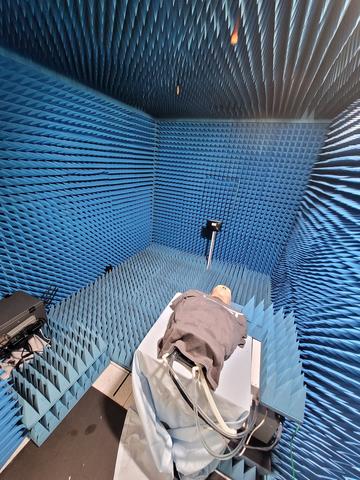2022-12-20 米国国立標準技術研究所(NIST)

Complete setup for the experiment using an off-the-shelf Wi-Fi router and receiving device. Using these commercial devices, NIST and its FDA collaborators were able to measure the manikin’s simulated “breathing,” differentiating between troubled and normal respiration.
Credit: S. Mosleh/NIST
このような相互作用によって、インターネット接続が中断されることはありませんが、誰かが困っているときに信号を送ることができるのです。NISTはBreatheSmartと呼ばれる深層学習アルゴリズムを開発しました。このアルゴリズムは、こうしたごくわずかな変化を分析し、部屋にいる誰かが息苦しそうにしているかどうかを判断するのに役立ちます。そして、すでに利用可能なWi-Fiルーターやデバイスでこれを実現することができるのです。この研究は、最近IEEE Accessに掲載されました。
Coder氏と研究員のSusanna Mosleh氏は、FDAの機器・放射線保健センターの科学技術研究所(OSEL)の同僚と協力して、既存のWi-Fiルーターを使って部屋にいる人の呼吸数を測定する新しい方法を開発しました。Wi-Fiでは、携帯電話やノートパソコンなどのクライアントからアクセスポイント(ルーターなど)に送信される一連の信号が「チャネル状態情報(CSI)」と呼ばれるものである。クライアント機器から送信されるCSI信号は常に同じで、CSI信号を受信したアクセスポイントは、それがどのようなものであるべきかを知っています。しかし、CSI信号が環境中を移動すると、物に跳ね返ったり強度が低下したりして歪んでしまいます。アクセスポイントは歪みの量を分析し、リンクを調整・最適化する。
これらのCSIストリームは1キロバイト未満と小さいため、チャネル上のデータの流れを妨げることはない。研究チームはルーターのファームウェアを変更し、これらのCSIストリームをより頻繁に、最大で毎秒10回要求して、信号の変化の様子を詳細に把握するようにしました。
<関連情報>
- https://www.nist.gov/news-events/news/2022/12/wi-fi-could-help-identify-when-youre-struggling-breathe
- https://ieeexplore.ieee.org/document/9989347
Wi-Fi CSIによる呼吸動作のモニタリング:性能とBreatheSmartアルゴリズムの特性評価 Monitoring Respiratory Motion with Wi-Fi CSI:Characterizing performance and the BreatheSmart Algorithm
Susanna Mosleh,Jason B. Coder,Christopher G. Scully,Keith Forsyth,Mohamad Omar Al Kalaa
IEEE Access Published:15 December 2022
DOI: 10.1109/ACCESS.2022.3230003
Abstract
Respiratory motion (i.e., motion pattern and rate) can provide valuable information for many medical situations. This information may help in the diagnosis of different health disorders and diseases. Wi-Fi-based respiratory monitoring schemes utilizing commercial off-the-shelf (COTS) devices can provide contactless, low-cost, simple, and scalable respiratory monitoring without requiring specialized hardware. Despite intense research efforts, an in-depth investigation on how to evaluate this type of technology is missing. We demonstrated and assessed the feasibility of monitoring and extracting human respiratory motion from Wi-Fi channel state information (CSI) data. This demonstration involves implementing an end-to-end system for a COTS-based hardware platform, control software, data acquisition, and a proposed processing algorithm. The processing algorithm is a novel deep-learning-based approach that exploits small changes in both CSI amplitude and phase information to learn high-level abstractions of breathing-induced chest movements and to reveal the unique characteristics of their difference. We also conducted extensive laboratory experiments demonstrating an assessment technique that can be replicated when quantifying the performance of similar systems. The results indicate that the proposed scheme can classify respiratory patterns and rates with an accuracy of 99.54% and 98.69%, respectively, in moderately degraded RF channels. Comprehensive data acquisition revealed the capability of the proposed system in detecting and classifying respiratory motions. Understanding the feasible limits and potential failure factors of Wi-Fi CSI-based respiratory monitoring scheme—and how to evaluate them—is an essential step toward the practical deployment of this technology. This study discusses ideas for further expansion of this technology.



